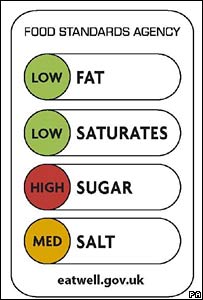UK government to eliminate pesky Food Standards Agency
As City University Professor Tim Lang explained (see yesterday’s post), which government is in power makes a big difference.
The new UK government is not wasting a minute before caving in to food industry demands.
First the government promised the food industry no new regulations. Now it is eliminating the Food Standards Agency (FSA), which is more or less the equivalent of our FDA. How come?
Would you believe front-of-package food labels?
According to the account in The Guardian (UK), this is happening because the FSA “fought a running battle with industry over the introduction of colour-coded ‘traffic light’ warnings for groceries, TV dinners and snacks.”
The FSA has led calls for the Europe-wide introduction of a traffic light system that required food companies to label the front of their products with red, amber or green symbols to denote the amounts of fat, saturated fat, salt and sugar contained per serving. The agency…said this was the best way to allow Europe’s increasingly obese shoppers to make informed decisions about the food they bought.
The British Medical Association, British Dietetic Association and British Heart Foundation are among health groups that supported the scheme…But traffic light labelling was buried by the European parliament last month, when MEPs backed a rival system favoured by multinationals such as Nestlé, Kraft and Danone.
The industry advocated “guideline daily amounts”, a system that listed percentages of recommended daily allowances included in each serving.
The food industry spent an estimated £830m on lobbying to stop the traffic lights scheme, which enjoyed a level of popularity with consumers because it was relatively easy to understand.
Note: That’s $1.247 billion to defeat traffic lights. Why? Because consumers know they aren’t supposed to buy products labeled with red dots. The food industry much prefers the incomprehensible Guideline Daily Amounts like the ones that Kellogg and General Mills were quick to put on their cereal boxes.
Getting rid of traffic lights was not enough. The food industry is so angry with FSA over the traffic light proposal that it lobbied the new government to axe the agency.
Mission accomplished (or maybe not).
Addition: Even responsible food industry commentators think this is a bad idea:
As regards the proposed splitting up of the FSA – we only have to look to the number of food safety scares in the US to see the consequences of its fragmented food safety approach.
So instead of putting the food watchdog to sleep, shouldn’t the UK government instead give it more teeth?
Update, July 14: Tim Lang and Geof Rayner did an editorial on this for the BMJ:
Mr Lansley’s thoughts imply that a combination of corporate and individual responsibility will do the trick. This is risky thinking. The Healthy Weight, Healthy Lives programme he inherits did not underplay the personal responsibility that individuals have for their weight, and it recognised that without system-wide action there would be little hope in turning around what already seemed to be the worst public health crisis since HIV….Ironically, by showing his hand early, Mr Lansley has done public health proponents a service. Tackling obesity requires bold efforts to shift how we live, but fiscal constraint should not be an excuse for ideological reassertion.



